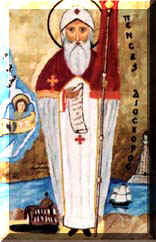Related Research Articles

The Council of Chalcedon was the fourth ecumenical council of the Christian church, convoked by Emperor Marcian. The council operated in Chalcedon, Bithynia from 8 October to 1 November, 451 and was attended by 520 bishops or their representatives. The gathering itself continues to represent the largest and best-documented of early councils. The principal purpose of the Council was to re-assert the doctrine of Council of Ephesus against the heresy derivative of Eutyches and Nestorius. Such heresies attempted to dismantle and separate Christ's divine nature from his humanity (Nestorianism) and further, to limit Christ as solely divine in nature (Monophysitism). As recorded by American Christian Scholar Jaroslav Pelikan, it was stated:
We all teach harmoniously [that he is] the same perfect in godhead, the same perfect in manhood, truly God and truly man, the same of a reasonable soul and body; homoousios with the Father in godhead, and the same homoousios with us in manhood ... acknowledged in two natures without confusion, without change, without division, without separation.

Justinian I, also known as Justinian the Great, was the Byzantine emperor from 527 to 565.
Pope Vigilius was the bishop of Rome from 29 March 537 to his death. He is considered the first pope of the Byzantine papacy. Born into Roman aristocracy, Vigilius served as a deacon and papal apocrisiarius in Constantinople. He allied with Empress Theodora, who sought his help to establish Monophysitism, and was made pope after the deposition of Silverius. After he refused to sign Emperor Justinian I's edict condemning the Three Chapters, Vigilius was arrested in 545 and taken to Constantinople. He died in Sicily while returning to Rome.
Tritheism is a nontrinitarian Christian heresy in which the unity of the Trinity and thus monotheism are denied. It represents more a "possible deviation" than any actual school of thought positing three separate deities. It was usually "little more than a hostile label" applied to those who emphasized the individuality of each hypostasis or divine person—Father, Son and Holy Spirit—over the unity of the Trinity as a whole. The accusation was especially popular between the 3rd and 7th centuries AD.
Jacob Baradaeus, also known as Jacob bar Addai or Jacob bar Theophilus, was the Bishop of Edessa from 543/544 until his death in 578. He is venerated as a saint in the Oriental Orthodox Churches and his feast day is 31 July. Jacob's missionary efforts helped establish the non-Chalcedonian Syriac Orthodox Church, also known as the "Jacobite" Church after its eponymous founder, and ensured its survival despite persecution.

Dioscorus I was the pope of Alexandria and patriarch of the See of St. Mark who was deposed by the Council of Chalcedon in 451. He was recognized as patriarch by the Coptic Church until his death. He died on the island of Gangra, Paphlagonia, in September 454. He is venerated as a saint by the Coptic and other Oriental Orthodox churches.

Severus the Great of Antioch, also known as Severus of Gaza, was the Patriarch of Antioch, and head of the Syriac Orthodox Church, from 512 until his death in 538. He is venerated as a saint in the Oriental Orthodox Church, and his feast day is 8 February.

The Photian Schism was a four-year (863–867) schism between the episcopal sees of Rome and Constantinople. The issue centred on the right of the Byzantine Emperor to depose and appoint a patriarch without approval from the papacy.

Theodora was an Eastern Roman empress by marriage to emperor Justinian. She became empress upon Justinian's accession in 527 and was one of his chief advisers, albeit from humble origins. Along with her spouse, Theodora is a saint in the Eastern Orthodox Church and in the Oriental Orthodox Church, commemorated on 14 November and 28 June respectively.
Ino, renamed Aelia Anastasia was the Empress consort of Tiberius II Constantine of the Byzantine Empire, and Augusta from 578 until her death.
Saint Ephraim of Antioch, also known as Saint Ephraim of Amida, was the Patriarch of Antioch, and head of the Greek Orthodox Church of Antioch, from 527 until his death in 545. He is venerated as a saint in the Eastern Orthodox Church and Roman Catholic Church, and his feast day is 8 June.

Aelia Sophia was the Empress consort of Justin II of the Byzantine Empire, and regent during the incapacity of her spouse from 573 until 578. She was interested in economic and financial matters during Justin's reign.
Paul II the Black, also known as Paul of Bēth Ukkāme, was the Patriarch of Antioch and head of the Syriac Orthodox Church from c. 551 or 564 to his deposition in 578. He succeeded Sergius of Tella as the spiritual leader of the Syrian non-Chalcedonians, in opposition to the Chalcedonian Imperial Church, and led the nascent Syriac Orthodox Church as it endured division and persecution.
Peter III of Callinicum was the Patriarch of Antioch and head of the Syriac Orthodox Church from 581 until his death in 591. He is commemorated as a saint by the Syriac Orthodox Church in the Martyrology of Rabban Sliba, and his feast day is 22 April.

Flavius Anastasius Paulus Probus Sabinianus Pompeius Anastasius was a politician of the Eastern Roman Empire.
Iwannis I was the Patriarch of Antioch and head of the Syriac Orthodox Church from 739/740 until his death in 754/755.
Sergius of Tella was the Patriarch of Antioch and head of the Syriac Orthodox Church from c. 544 to c. 547 or c. 557 to 560.
Athanasius IV Salhoyo was the Patriarch of Antioch and head of the Syriac Orthodox Church from 986/987 until his death in 1002/1003.
Simeon of Beth Arsham was a Syrian bishop who spread his teachings at the beginning of the sixth century. He was the bishop of Beth Arsham, which was located near Seleucia-Ctesiphon.
Athanasius III was the Patriarch of Antioch and head of the Syriac Orthodox Church from 724 until his death in 739/740.